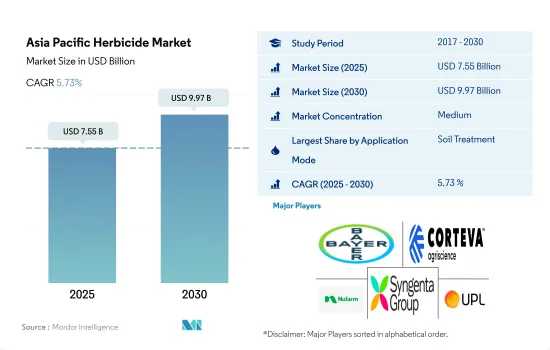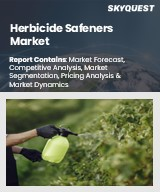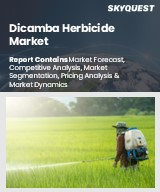
|
시장보고서
상품코드
1683979
아시아태평양의 제초제 시장 : 시장 점유율 분석, 산업 동향, 성장 예측(2025-2030년)Asia Pacific Herbicide - Market Share Analysis, Industry Trends & Statistics, Growth Forecasts (2025 - 2030) |
||||||
■ 보고서에 따라 최신 정보로 업데이트하여 보내드립니다. 배송일정은 문의해 주시기 바랍니다.
아시아태평양의 제초제 시장 규모는 2025년에 75억 5,000만 달러로 추정되고, 2030년에는 99억 7,000만 달러에 이를 것으로 예측되며, 예측 기간 2025년부터 2030년까지 CAGR 5.73%로 성장할 것으로 예측됩니다.

잡초의 만연과 그에 따른 농작물의 수율 감소가 시장을 견인
- 아시아태평양에는 쌀, 밀, 옥수수, 콩 등의 주식작물과 면화, 사탕수수, 과일, 야채 등의 환금작물 등 다양한 작물이 재배되고 있으며, 이들 작물은 여러 잡초종에 의한 과제에 직면하고 있습니다. 2022년 토양 처리법은 아시아태평양의 제초제 시장에서 가장 큰 점유율 46.8%를 차지했으며, 시장 규모는 30억 달러에 달했습니다. 토양 처리는 제초제를 토양에 직접 살포하는 것으로, 잡초 방제의 효과적인 수단으로 작용합니다. 이 방법은 토양에 존재하는 잡초의 씨앗, 모종 또는 정착된 잡초를 대상으로 작물의 심기 전 또는 이삭 후에 사용할 수 있습니다.
- 2022년에는 제초제의 엽면 살포는 32.6% 시장 점유율을 차지했으며, 21억 달러로 평가되었습니다. 이 방법은 활엽 잡초, 수염, 쌀과 식물, 심지어 수생 잡초를 표적으로 하는 데 매우 효과적입니다. 이 잡초 잎에 제초제를 직접 살포하여 최대한의 흡수와 방제를 달성할 수 있습니다. 엽면 살포의 유연성으로 농부는 잡초가 활발하게 자라는 단계를 노리고 최적의 결과를 얻을 수 있습니다.
- 2022년에 화학적 살포는 제초제 살포 방법의 18.9%를 차지하였고 12억 달러로 평가되었습니다. 이 성장은 마이크로 관개 시스템의 채용이 증가하고 있으며, 제초제의 살포가 용이하며, 농지 전체에 균일하게 넘어가는 요인입니다.
- 훈증은 특히 다른 방법에서는 효과가 낮은 폐쇄 환경에서 효과적이고 적대적인 잡초 방제를 실시할 수 있습니다. 다른 방법으로는 방제가 곤란한 잡초의 씨앗, 뿌리계, 번식체에도 도달할 가능성이 있습니다.
- 각 기법의 장점과 특이성으로 인해 각 기법 시장은 예측 기간 동안 성장할 것으로 예상됩니다.
벼와 같은 주요 작물에 제초제의 사용이 지역 전체에서 확대
- 아시아태평양의 제초제 시장은 과거 일정 기간에 꾸준한 성장을 이루었고, 2022년에는 이 지역이 세계 제초제 시장에서 큰 점유율을 차지했습니다. 부타크롤, 프로파닐, 프리틸라크롤, 2,4-D, 비스피리백 나트륨, 시할로홉 부틸 등이 이 지역에서 일반적으로 사용되는 제초제입니다.
- 아시아에서는 쌀이 가장 중요한 작물이며 세계 쌀 생산과 소비의 90%를 차지합니다. 아시아태평양은 쌀과 같은 주요 식용 곡물의 가장 큰 수출국과 생산국이기 때문에 제초제는 주로 곡물 및 곡류에 사용됩니다. 곡물 및 곡류 부문은 2022년 금액 기준으로 56.6%의 점유율을 차지했습니다.
- 이 지역의 많은 국가들은 수율 손실을 최소화하기 위해 사용 가능한 모든 호환 방제 전술을 사용하는 통합 잡초 관리법을 채택하고 있습니다. 새로 도입된 잡초는 다른 지역으로 퍼지기 전에 즉시 제거해야 하지만 제초제를 사용하여 방제할 수 있습니다. 필리핀의 누에바에시하 주와 일로일로 주에서는 문화적 관리와 제초제의 적절한 사용을 결합하여 수율이 각각 약 10%에서 15% 증가했습니다.
- 그러나 잡초 집단에 제초제 내성이 발생하면 효과적인 잡초 관리를 위한 제초제의 선택이 제한되기 때문에 큰 과제가 되고 있습니다. 동시에 일본과 같은 다양한 국가의 정부는 새로운 잡초와 그에 상응하는 제초제를 발견하기 위한 연구 이니셔티브에 투자하고 있습니다. 이러한 정책은 농부들이 작물 보호 관행을 채택하도록 장려하고 있으며, 이 부문의 성장에 기여하는 것을 목표로 합니다. 이 부문은 예측 기간(2023-2029년)에 CAGR 6.1%를 나타낼 것으로 예상됩니다.
아시아태평양의 제초제 시장 동향
벼와 같은 주요 작물에서 잡초 확산이 증가하고 효율적인 잡초 방제가 필요하며 헥타르 당 제초제 소비량이 증가
- 아시아태평양에서는 헥타르당 제초제 사용량이 과거 기간에 비해 크게 증가했습니다. 이것은 농업에서 잡초의 확산으로 인한 것이며, 잡초는 다양한 질병의 중재자로 작용하여 그 지역에서 곰팡이 감염이 증가하고 작물 손실이 증가하고 있습니다. 일본은 역사적 기간에 1헥타르당 제초제 소비량이 대폭 증가하고, 기타 아시아태평양보다 약 7% 높다고 추정되었습니다. 이 나라의 헥타르당 제초제 사용량 증가는 농가의 고령화, 노동력 부족, 농지 증가 등 다양한 요인이 겹치기 때문입니다. 그 결과 쌀과 콩과 같은 주요 작물의 잡초 관리는 수작업 제초에서 제초제 사용으로 전환되었습니다.
- 미얀마의 1헥타르당 제초제 소비량은 지역 2위로 2022년에는 1헥타르당 2,200그램이 소비되었고, 2017년 1,600그램보다 증가했습니다. 이 증가는 잡초를 방제하고 쌀과 같은 주요 작물의 농업 생산을 향상시키기 위한 적절한 잡초 관리 기술의 도입으로 인한 것입니다. 잡초에 의한 벼농사의 평균 수율 손실은 건기에서는 약 65%, 우기에서는 약 34%입니다. 이 나라의 농부들은 주요 작물의 잡초 방제에 제초제 제품에 크게 의존하기 때문에 헥타르당 제초제 소비량이 증가하고 있습니다.
- 전체 아시아태평양에서는 주요 작물에서 잡초 발생이 증가했기 때문에 중국을 제외한 모든 국가에서 헥타르 당 제초제 사용량이 전년 동기 대비 증가했습니다. 그러나 중국은 농약의 제로 성장 정책을 시행하고 있기 때문에 다른 잡초 방제 방법을 사용하고 있습니다.
기후 변화가 작물 식물에 스트레스를 주기 때문에 잡초의 성장이 증가하며 시장을 견인하고 있습니다.
- 메트리부딘은 광합성을 억제함으로써 옥수수, 사탕수수, 감자, 토마토와 같은 주요 작물의 넓은 잎 잡초를 방제하는 데 사용되는 선택적 침투성 제초제입니다. 2022년 가격은 톤당 16,600달러였습니다.
- 아트라진은 옥수수와 벼농사에서 에키노크로아, 엘신속, 아마란사스빌리지스 등의 활엽잡초나 벼과 잡초의 방제에 널리 사용되는 제초제입니다. 이 제초제는 2022년에 1만 3,800달러로 평가되었습니다.
- 파라코트는 그라목슨의 유효 성분으로, 잡초와 잔디의 방제에 사용됩니다. 또한 수확 전 면화 등의 작물 건조에도 사용됩니다. 파라코트는 2022년에 1톤당 4,600달러로 평가되었습니다. 중국은 파라코트 수출 대국으로 파라코트 생산량의 80% 이상이 세계 각국에 수출되고 있습니다.
- 펜디메탈린은 2022년에 1톤당 3,300달러로 평가되는 선택적 출아 전 제초제입니다. 감자, 담배, 설탕, 쌀, 사탕수수 작물의 1년생 풀과 활엽 잡초를 폭넓게 방제합니다. 마찬가지로 2,4-디클로로페녹시아세트산(2,4-D)은 일반적인 침투성 제초제로 2022년 가격은 톤당 2,300달러로 평가되었습니다. 잔디, 밭, 과일, 야채 작물의 활엽 잡초의 방제에 사용됩니다.
- 글리포세이트는 유기 인계 광역 스펙트럼 침투성 제초제 및 작물 건조제이며, 2022년 가격은 톤당 1,100달러였습니다. 글리포세이트는 주로 벼과, 수염과, 활엽수와 같은 잡초를 방제하는 데 사용됩니다.
- 기후 변화는 식물에 손상이나 스트레스를 주고, 극단적인 스트레스 조건 하에서는 생존할 수 없기 때문에 식물의 건강에 악영향을 미치고, 잡초의 성장을 증가시킵니다. 이것은 또한 제초제 수요 증가로 이어지고, 유효 성분의 가격을 밀어 올립니다.
아시아태평양의 제초제 산업 개요
아시아태평양의 제초제 시장은 적당히 통합되어 있으며 상위 5개사에서 50.02%를 차지하고 있습니다. 이 시장 주요 기업은 다음과 같습니다. Bayer AG, Corteva Agriscience, Nufarm Ltd, Syngenta Group 및 UPL Limited.
기타 혜택
- 엑셀 형식 시장 예측(ME) 시트
- 3개월의 애널리스트 서포트
목차
제1장 주요 요약 및 주요 조사 결과
제2장 보고서 제안
제3장 서문
- 조사 전제조건 및 시장 정의
- 조사 범위
- 조사 방법
제4장 주요 산업 동향
- 1헥타르당 농약 소비량
- 유효성분의 가격 분석
- 규제 프레임워크
- 호주
- 중국
- 인도
- 인도네시아
- 일본
- 미얀마
- 파키스탄
- 필리핀
- 태국
- 베트남
- 밸류체인 및 유통채널 분석
제5장 시장 세분화
- 적용 모드별
- 약제 살포
- 엽면 살포
- 훈증
- 토양치료
- 작물 유형별
- 상업 작물
- 과일 및 야채
- 곡물
- 콩류 및 지방종자
- 잔디 및 관상용
- 국가별
- 호주
- 중국
- 인도
- 인도네시아
- 일본
- 미얀마
- 파키스탄
- 필리핀
- 태국
- 베트남
- 기타 아시아태평양
제6장 경쟁 구도
- 주요 전략 동향
- 시장 점유율 분석
- 기업 상황
- 기업 프로파일(세계 수준 개요, 시장 수준 개요, 주요 사업 부문, 재무, 직원 수, 주요 정보, 시장 순위, 시장 점유율, 제품 및 서비스, 최근 동향 분석 포함)
- ADAMA Agricultural Solutions Ltd
- BASF SE
- Bayer AG
- Corteva Agriscience
- FMC Corporation
- Jiangsu Yangnong Chemical Co. Ltd
- Nufarm Ltd
- Rainbow Agro
- Syngenta Group
- UPL Limited
제7장 CEO에 대한 주요 전략적 질문
제8장 부록
- 세계의 개요
- 개요
- Porter's Five Forces 분석 프레임워크
- 세계 밸류체인 분석
- 시장 역학(DROs)
- 정보원 및 참고문헌
- 도표 일람
- 주요 인사이트
- 데이터 팩
- 용어집
The Asia Pacific Herbicide Market size is estimated at 7.55 billion USD in 2025, and is expected to reach 9.97 billion USD by 2030, growing at a CAGR of 5.73% during the forecast period (2025-2030).

The market is being driven by increasing weed infestation and associated yield losses in crops
- The Asia-Pacific region is home to a diverse range of crops, encompassing staple food crops like rice, wheat, corn, and soybeans, as well as cash crops such as cotton, sugarcane, fruits, and vegetables, which face challenges from several weed species. In 2022, the soil treatment method accounted for the largest share of 46.8% in the Asia-Pacific herbicide market, representing a value of USD 3.0 billion. Soil treatment involves the direct application of herbicides to the soil, serving as an effective means of weed control. This method can be utilized either before planting or after crop emergence, targeting weed seeds, seedlings, or established weeds present in the soil.
- In 2022, foliar application of herbicides held a market share of 32.6% and was valued at USD 2.1 billion. This method is highly effective in targeting broadleaf weeds, sedges, grasses, and even aquatic weeds. By directly applying herbicides to the foliage of these weeds, maximum absorption and control can be achieved. The flexibility of foliar application allows farmers to target weeds during their active growth stages for optimal results.
- In 2022, chemigation accounted for 18.9% of herbicide application methods, valued at USD 1.2 billion. This growth is attributed to the increasing adoption of micro-irrigation systems and the ease of herbicide application, ensuring uniform distribution throughout the cropland.
- Fumigation can provide effective and targeted weed control, especially in enclosed environments where other methods may be less effective. It can reach weed seeds, root systems, and weed propagules that are difficult to control through other means.
- Owing to the advantages and specificity of each method, the market for each method is anticipated to grow during the forecast period.
The use of herbicides for major crops like rice is growing across the region
- The herbicide market in Asia-Pacific witnessed steady growth during the historical period, with the region occupying a significant share of the global herbicide market in 2022. Butachlor, propanil, pretilachlor, 2,4-D, bispyribac-sodium, and cyhalofop-butyl are the commonly used herbicides in the region.
- Rice is by far the most important crop in Asia; the region accounts for 90% of the world's production and consumption of rice. Herbicides are mostly used for grains and cereals in the Asia-Pacific as the region is the largest exporter and producer of staple grains such as rice. The grains & cereals segment occupied a share of 56.6% by value in 2022.
- Many countries in the region have adopted the Integrated weed Management method that entails the use of all available compatible control tactics to minimize yield losses. Newly introduced weeds that would require immediate eradication before they spread to other areas can be controlled with the use of herbicides. It was observed that combining cultural management practices and judicious herbicide usage resulted in higher yields of about 10% to 15% in the Nueva Ecija and Iloilo provinces of the Philippines, respectively.
- However, the occurrence of herbicide resistance in weed populations presents a big challenge as it limits herbicide choices for effective weed management. At the same time, governments of various countries like Japan are investing in research initiatives to discover new weeds and their subsequent herbicides. Such policies are encouraging farmers to adopt crop protection practices that aim to contribute to the growth of the segment. The segment is expected to record a CAGR of 6.1% during the forecast period (2023-2029).
Asia Pacific Herbicide Market Trends
Increased weed infestations in major crops like rice need efficient weed control, boosting the per hectare herbicide consumption
- In the Asia-Pacific region, the use of herbicides per hectare significantly increased over the historical period. This is due to the prevalence of weeds in agriculture, which are acting as vectors for a variety of diseases, resulting in an increase in fungal infections and crop loss in the region. Japan experienced a significant rise in herbicide consumption per hectare over the historical period, which was estimated to be approximately 7% higher than the rest of the Asia-Pacific region. The increasing use of herbicides per hectare in the country is attributed to a combination of factors, including the aging of farmers, a lack of labor, and an increase in agricultural land. This resulted in a shift from manual weeding to the use of herbicides for weed management in major crops such as rice and soybeans.
- Myanmar ranks second in the region in terms of herbicide consumption per hectare, with 2,200 grams of herbicide per hectare consumed in 2022, an increase over the 1,600 grams consumed in 2017. This increase is largely attributed to the implementation of appropriate weed management techniques to control weeds and enhance agricultural production in key crops such as rice. The average yield losses in rice crops due to weeds are approximately 65% and 34% in the dry and wet seasons, respectively. Farmers in the country are majorly reliant on herbicide products to control weeds in major crops, which has led to increased consumption of herbicides per hectare.
- Overall, in the Asia-Pacific region, herbicide use per hectare increased Y-o-Y in all countries except China, as weed infestations increased in the major crops. However, China is using other weed control methods as it implements zero growth policies in pesticides.
Climate change causing stress to crop plants, thus leading to increased weed growth driving the market
- Metribuzin is a selective and systemic herbicide used to control broadleaf weeds in major crops like corn, sugarcane, potatoes, and tomatoes by inhibiting photosynthesis. In 2022, it was priced at USD 16.6 thousand per metric ton.
- Atrazine is an herbicide widely used for the control of broadleaf and grassy weeds like Echinocloa, Elusine spp., and Amaranthus viridis in maize and rice crops. The herbicide was valued at a price of USD 13.8 thousand in 2022.
- Paraquat is the active ingredient in Gramoxone, which is used to control weeds and grasses. It is also used for the desiccation of crops, like cotton, prior to harvest. Paraquat was valued at a price of USD 4.6 thousand per metric ton in 2022. China is a major paraquat export country, and over 80% of its paraquat output is exported to countries worldwide.
- Pendimethalin is a selective pre-emergence herbicide valued at USD 3.3 thousand per metric ton in 2022. It offers broad-spectrum control of annual grasses and broadleaf weeds in potato, tobacco, sorghum, rice, and sugarcane crops. Similarly, 2,4-dichlorophenoxyacetic acid (2,4-D) is a common systemic herbicide that was valued at a price of USD 2.3 thousand per metric ton in 2022. It is used in the control of broadleaf weeds in turf, lawn, field, fruit, and vegetable crops.
- Glyphosate is an organophosphorus broad-spectrum systemic herbicide and crop desiccant, priced at USD 1.1 thousand per metric ton in 2022. Glyphosate is mainly used to control weeds like grasses, sedges, and broadleaves.
- Climate change can cause damage and stress to plants and be detrimental to plant health as they cannot survive in extreme stress conditions, leading to increased weed growth. This further leads to an increase in herbicide demand, thereby boosting the prices of active ingredients.
Asia Pacific Herbicide Industry Overview
The Asia Pacific Herbicide Market is moderately consolidated, with the top five companies occupying 50.02%. The major players in this market are Bayer AG, Corteva Agriscience, Nufarm Ltd, Syngenta Group and UPL Limited (sorted alphabetically).
Additional Benefits:
- The market estimate (ME) sheet in Excel format
- 3 months of analyst support
TABLE OF CONTENTS
1 EXECUTIVE SUMMARY & KEY FINDINGS
2 REPORT OFFERS
3 INTRODUCTION
- 3.1 Study Assumptions & Market Definition
- 3.2 Scope of the Study
- 3.3 Research Methodology
4 KEY INDUSTRY TRENDS
- 4.1 Consumption Of Pesticide Per Hectare
- 4.2 Pricing Analysis For Active Ingredients
- 4.3 Regulatory Framework
- 4.3.1 Australia
- 4.3.2 China
- 4.3.3 India
- 4.3.4 Indonesia
- 4.3.5 Japan
- 4.3.6 Myanmar
- 4.3.7 Pakistan
- 4.3.8 Philippines
- 4.3.9 Thailand
- 4.3.10 Vietnam
- 4.4 Value Chain & Distribution Channel Analysis
5 MARKET SEGMENTATION (includes market size in Value in USD and Volume, Forecasts up to 2030 and analysis of growth prospects)
- 5.1 Application Mode
- 5.1.1 Chemigation
- 5.1.2 Foliar
- 5.1.3 Fumigation
- 5.1.4 Soil Treatment
- 5.2 Crop Type
- 5.2.1 Commercial Crops
- 5.2.2 Fruits & Vegetables
- 5.2.3 Grains & Cereals
- 5.2.4 Pulses & Oilseeds
- 5.2.5 Turf & Ornamental
- 5.3 Country
- 5.3.1 Australia
- 5.3.2 China
- 5.3.3 India
- 5.3.4 Indonesia
- 5.3.5 Japan
- 5.3.6 Myanmar
- 5.3.7 Pakistan
- 5.3.8 Philippines
- 5.3.9 Thailand
- 5.3.10 Vietnam
- 5.3.11 Rest of Asia-Pacific
6 COMPETITIVE LANDSCAPE
- 6.1 Key Strategic Moves
- 6.2 Market Share Analysis
- 6.3 Company Landscape
- 6.4 Company Profiles (includes Global level Overview, Market level overview, Core Business Segments, Financials, Headcount, Key Information, Market Rank, Market Share, Products and Services, and analysis of Recent Developments)
- 6.4.1 ADAMA Agricultural Solutions Ltd
- 6.4.2 BASF SE
- 6.4.3 Bayer AG
- 6.4.4 Corteva Agriscience
- 6.4.5 FMC Corporation
- 6.4.6 Jiangsu Yangnong Chemical Co. Ltd
- 6.4.7 Nufarm Ltd
- 6.4.8 Rainbow Agro
- 6.4.9 Syngenta Group
- 6.4.10 UPL Limited
7 KEY STRATEGIC QUESTIONS FOR CROP PROTECTION CHEMICALS CEOS
8 APPENDIX
- 8.1 Global Overview
- 8.1.1 Overview
- 8.1.2 Porter's Five Forces Framework
- 8.1.3 Global Value Chain Analysis
- 8.1.4 Market Dynamics (DROs)
- 8.2 Sources & References
- 8.3 List of Tables & Figures
- 8.4 Primary Insights
- 8.5 Data Pack
- 8.6 Glossary of Terms
샘플 요청 목록



















